
Sea urchins, or Rizzi in Malta, are fascinating creatures with a variety of species globally. They are a delicacy in many cuisines, including the Mediterranean, but overfishing poses a threat to their population. It's vital to consume them responsibly and appreciate their unique flavours.
“Don’t stand on that ! Don’t touch it ! and put your swimming shoes on now!”
– My Mother
Were phrases that rang in my ears until I instinctively knew to avoid rizzi like the plague, it wasn’t until some time later in a top London restaurant that I came to realise the very things I had avoided like my life depended on it, actually tasted like ‘nectar of the sea’. Intrigued as to how much these sublime creatures appeared on the tables of ordinary folk like me, I set about the task of finding out. My curiosity took me to Marsascala, Marsaxlokk, Cirkewwa, Zurrieq and many other coastal places with no luck at all, it was only when I was at the point of giving up, that it was pointed out to me that my next door neighbour regularly dived for Rizzi in Gnejna.

Thank goodness for Raymond Schembri ! He laughed out loud when I told him, but was more than happy to help me out.
Sea urchins are spiny, hard shelled animals that live on the seafloor in oceans all around the world. They belong to the phylum Echinodermata, class Echinoidea, and in common with most Echinodermata they have radial symmetry which is pentardial – the majority of their organs being repeated along five sectors. Actually scrub that, they are the black spiny things on the sea floor your mother tells you not to stand on, and in Malta we call them Rizzi. Varieties of sea urchins can be found in all marine environments and are a popular delicacy in many cuisines around the world.
Raymond told me to meet him at his boathouse in Gnejna late afternoon and when I arrived he had half a bucket of rizzi and was in the process of diving for more. Raymond only takes enough Rizzi to feed himself and his lovely wife Marthese and I have to say after seeing her do most of the work she deserved the treat that was coming.
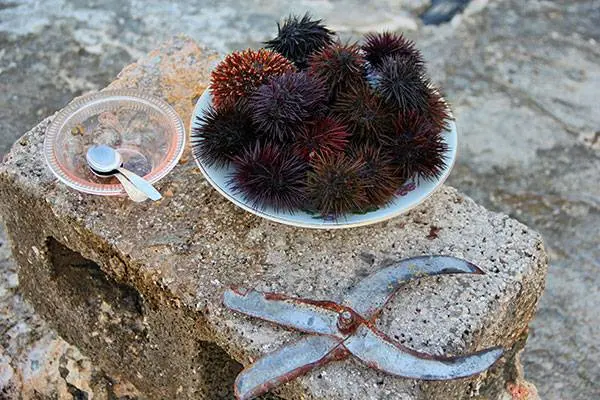
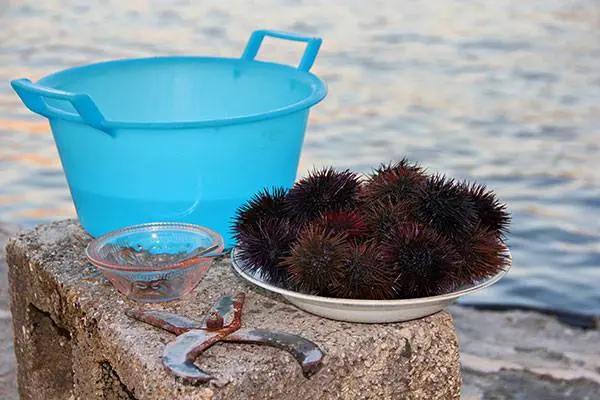
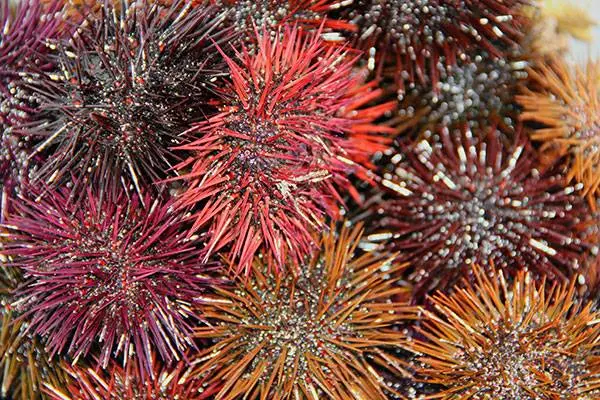
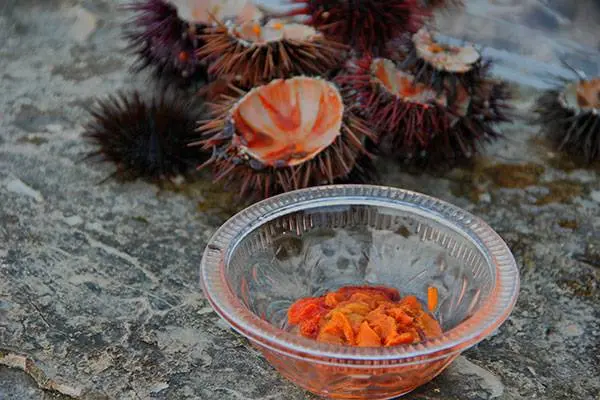


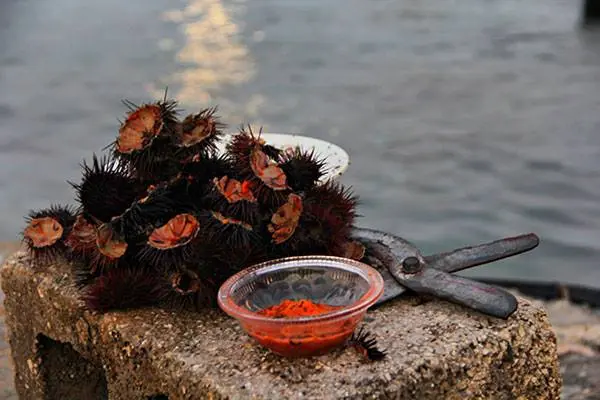
Although they are not currently in fear of extinction, increasing demands for sea urchins in certain parts of the world has led to overfishing. Unless more attention is paid to this, together with the impact of changing climates, there may be the real potential for sea urchins to become endangered. So its important not to take more than you are going to eat.
The first thing that struck me about Raymonds haul, was the variations in size, colours and types, Apparently there are over 700 different varieties of sea urchins found in oceans around the world. While some are not edible, many are and have become intrinsic parts of cuisines in many countries. For example, the New Zealand sea urchin, Evechinus chloroticus, is considered a delicacy amongst Maori and is eaten raw. Similarly, slate pencil urchins are a popular dish in the West Indies.
Paracentrotus lividus and Arbacia lixula are the two most common species of sea urchins in the Mediterranean area. Paracentrotus lividus is a key ingredient in many Mediterranean dishes and is often eaten raw with lemon. This sea urchin is also used as a flavouring for fish soup, omelettes, scrambled eggs and mayonnaise. While both species are suitable for consumption by humans, Arbacia lixula is generally less appreciated due to the smaller size of their gonads but It is considered a particular delicacy in Spanish cooking however and forms an intrinsic part of their seafood cuisine

Raymond hauled his catch to shore with a grin from ear to ear and Marthese had his tools and implements ready for him. He sorted through the Rizzi replacing ones that were too small back into the sea and with an ancient pair of Rizzi cutters he crunched his way through the tough shells. Laying them out for Marthese to harvest the gonads.
While sea urchins may not automatically be thought of as edible by many people, their roe (the ‘gonads’ – or the eggs and reproductive organs) have long been an extremely popular choice in Japanese sushi and in the cuisines of other cultures including Chile and Korea… as well as many parts of the Mediterranean.

Indeed, Japan is the world’s biggest importer and consumer of sea urchins. The fresh sea urchin roe is eaten raw as a form of sushi or sashimi. Sea urchin roe is more commonly known as ‘Uni’ and is often found on top of sushi rolls delicately sliced. It is enjoyed for its soft buttery texture which melts in your mouth with its taste generally dependant on the region from which it was harvest and whether it is in season.
Sea urchins are also an important part of Chilean cuisine. Although declining in overall popularity, they remain popular with many Chileans and are a key ingredient in a number of traditional dishes. The sea urchins are usually consumed raw with a green sauce made of parsley, lemon juice, onion and oil, or in a tortilla de erizos (an omelette), or in sauces to accompany other forms of sea food. The consumption of sea urchins have a particularly long history in Chile. Their remains have been discovered in archaeological sites dating back over 11,000 years.
“Sea urchins make for a healthy meal and snack option with only 125 calories per 100 grams. The low calories associated with sea urchin is not the only reason for its popularity – it is considered a highly effective aphrodisiac by the Japanese. In addition, they are rich in fiber and protein, and an excellent source of Vitamins A, C and E together with calcium and iodine.”
With all that in mind I’m sure .. Marthese now had a big bowl of succulent Rizzi and with her pot of pasta water boiling furiously, she sautes some onions and with the addition of some local tomatoes she makes a simple tomato sauce, I’m not going to go into details as to how she made her ‘Spaghetti bir-Rizzi’ as i’m sure we all have our different methods but with a toss of the pasta and the addition of the sauce and finally the Rizzi I was presented with a bowl of the sweetest Mediterranean pasta I’ve had in a long time.
With some home made wine, a loaf of the finest bread from Victors bakery we ate like kings, such simple pleasures caught no more than 10 metres away, simply cooked and with the finest of Maltese hospitality, this is the Malta I had hoped to find.

At Med.kitchen, our passion lies in crafting exceptional culinary experiences through our online platform. We specialise in sharing a wealth of knowledge via articles, recipes, courses, and online mentoring, aiming to inspire both novice and seasoned chefs alike. Our focus has shifted from private dining to being an online source of gastronomic inspiration, allowing you to explore and refine your culinary skills from the comfort of your home..